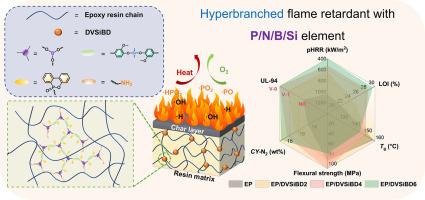A hyperbranched P/N/B/Si-containing multi-element flame retardant for high performance and fire safety epoxy thermosets
IF 7.4
2区 化学
Q1 POLYMER SCIENCE
引用次数: 0
Abstract
Although epoxy resins (EPs) exhibit superior overall performance, their use in advanced applications is restricted due to their inherent flammability. Improving epoxy thermosets' flame resistance without sacrificing their overall qualities is still challenging. In this work, a hyperbranched structural flame retardant (DVSiBD) with four flame retardant elements (P, N, B and Si) was synthesized and incorporated into EP to prepare retardant thermosets. The thermosets achieved a UL-94 V-0 rating and a limiting oxygen index (LOI) of 28.3 % following incorporating 4 wt% DVSiBD. Simultaneously, there was a 49.8 % decrease in the peak heat release rate (pHRR) and a 17.4 % reduction in the total heat release (THR). The improved flame-retardant efficacy of DVSiBD is chiefly attributable to the synergistic effects of the phosphorus and nitrogen chain segments, alongside the silicon and boron derivatives, as confirmed by a comprehensive analysis of the condensed and gas phases. Additionally, DVSiBD catalyzed and participated in the curing of EP, resulting in EP thermosets with higher cross-linking density, while preserving high glass transition temperature (Tg) and thermal decomposition temperature. Attributed to its flexible Si-O bond and rigid DOPO aromatic unit, the flexural and impact strength of EP thermosets containing 4 wt% DVSiBD was improved by 17.5 % and 39.9 % compared with EP thermosets without DVSiBD, respectively. This work offers a viable approach for the development of hyperbranched flame retardants that contain P, N, B, and Si flame retardant elements, as well as for the enhancement of the retardancy of EP thermosets.

一种超支化P/N/B/ si多元素阻燃剂,用于高性能防火环氧热固性树脂
虽然环氧树脂(EPs)具有优越的综合性能,但由于其固有的可燃性,其在高级应用中的应用受到限制。在不牺牲其整体质量的情况下提高环氧热固性阻燃性仍然具有挑战性。本文合成了一种含有P、N、B、Si四种阻燃元素的超支化结构阻燃剂(DVSiBD),并将其掺入EP中制备了阻燃热固性阻燃剂。在加入4 wt% DVSiBD后,热固性材料达到了UL-94 V-0额定值,极限氧指数(LOI)为28.3%。同时,峰值放热率(pHRR)降低了49.8%,总放热率(THR)降低了17.4%。DVSiBD阻燃性能的提高主要是由于磷和氮链段以及硅和硼衍生物的协同作用,这一点在凝聚相和气相的综合分析中得到了证实。此外,DVSiBD催化并参与了EP的固化,得到了交联密度更高的EP热固性材料,同时保持了较高的玻璃化转变温度(Tg)和热分解温度。由于其具有柔性Si-O键和刚性DOPO芳香单元,含有4 wt% DVSiBD的EP热固性材料的弯曲强度和冲击强度分别比不含DVSiBD的EP热固性材料提高了17.5%和39.9%。这项工作为开发含有P、N、B和Si阻燃元素的超支化阻燃剂以及增强EP热固性阻燃剂提供了一条可行的途径。
本文章由计算机程序翻译,如有差异,请以英文原文为准。
求助全文
约1分钟内获得全文
求助全文
来源期刊

Polymer Degradation and Stability
化学-高分子科学
CiteScore
10.10
自引率
10.20%
发文量
325
审稿时长
23 days
期刊介绍:
Polymer Degradation and Stability deals with the degradation reactions and their control which are a major preoccupation of practitioners of the many and diverse aspects of modern polymer technology.
Deteriorative reactions occur during processing, when polymers are subjected to heat, oxygen and mechanical stress, and during the useful life of the materials when oxygen and sunlight are the most important degradative agencies. In more specialised applications, degradation may be induced by high energy radiation, ozone, atmospheric pollutants, mechanical stress, biological action, hydrolysis and many other influences. The mechanisms of these reactions and stabilisation processes must be understood if the technology and application of polymers are to continue to advance. The reporting of investigations of this kind is therefore a major function of this journal.
However there are also new developments in polymer technology in which degradation processes find positive applications. For example, photodegradable plastics are now available, the recycling of polymeric products will become increasingly important, degradation and combustion studies are involved in the definition of the fire hazards which are associated with polymeric materials and the microelectronics industry is vitally dependent upon polymer degradation in the manufacture of its circuitry. Polymer properties may also be improved by processes like curing and grafting, the chemistry of which can be closely related to that which causes physical deterioration in other circumstances.
 求助内容:
求助内容: 应助结果提醒方式:
应助结果提醒方式:


